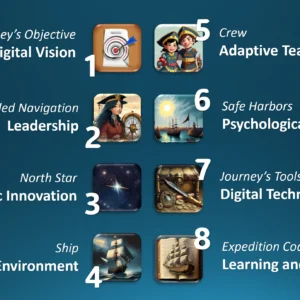Digital transformation is a buzzword that’s been echoing in boardrooms and flooding your LinkedIn feed. But let’s be honest, it often feels like everyone’s talking, but no one’s really saying anything.
So, what’s the real deal? This article aims to cut through the noise and give you the lowdown on what digital transformation truly means.
Spoiler alert: Digital Transformation is not just about the Cloud, AI or other modern digital technologies.
Digitization vs. Digital Transformation
Digitization is the process of converting analog information into digital form. It’s crucial not to confuse digitization with digital transformation. The latter involves a paradigm shift in the entire organization, affecting not just material resources but also, significantly, employees’ mindset and company culture.
Digital transformation is the strategic evolution of a business, affecting how it operates and delivers value to customers. More than just a technology update. Integrating technology, data, and continuous improvement is a cultural shift to enhance competitiveness and ensure sustainability.

Purpose of Digital Transformation
Create Competitive Advantage
Embracing digital transformation allows businesses to stay competitive in the fast-paced tech and complex world. This is important as it introduces new growth possibilities and helps develop new business models.
Enhance Efficiency and Productivity
Digital transformation optimizes workflows, automates manual tasks, and improves operational efficiency.
Improve Customer Experience
Digital transformation enables organizations to enhance customer experiences by providing personalized, seamless, and convenient interactions across various touchpoints. It allows for better customer engagement, faster response times, and tailored offerings, ultimately increasing customer satisfaction and loyalty.
Keys to Start a Successful Digital Transformation
- Digital Vision & Leadership Commitment: The leadership team must be fully committed to the objectives of digital transformation.
- Customer-Centric Innovation: Focusing on customer needs guides innovation in digital transformation. The goal is not to rush ahead using new technologies but to listen to our customers and let them guide our actions in the digital world.
- Ambidextrous Culture and Environment: The organization must balance exploring new digital avenues with optimizing current ones. An ambidextrous culture and processes that allow exploration and exploitation ensure keeping existing businesses running and innovation. This helps businesses capitalize on opportunities and maximize strengths in the digital age.
- Continuous Learning: Companies must keep up with new technologies and foster a culture of continuous learning and adaptation. This can help them close the gap and ensure they are leveraging the full potential of digital transformation.
Action Plan for Digital Transformation
- Define Organizational Purpose: Start by defining the purpose of your organization, which will guide the entire transformation journey.
- Initial Assessment: Assess your current digital maturity level to understand your starting point.
- Identify and Prioritize Processes to Transform: Identify which processes or areas need transformation and prioritize them based on their impact, feasibility, and alignment with your organizational purpose.
- Manage and Implement Transformation: Execute your digital transformation plan while managing resources, timelines, and milestones. Ensure that new systems and activities are integrated into your organizational processes.
- Evaluate and Learn: Evaluate the transformation, gather learnings, and activate them.
- Re-evaluate the Purpose and Re-Assessment: Treat digital transformation as an ongoing process of short iterations (less than six months). Continuously monitor performance metrics and gather feedback and learnings for optimization and improvement, always aligned with your organizational purpose. Start the next iteration again. (Step 3)

Benefits of Digital Transformation
Faster Adaptation in a Volatile, Uncertain, and Complex (VUCA) Arena
Organizations embracing digital transformation are better prepared to adapt to new circumstances continuously. This adaptability is not just a survival mechanism; it’s a competitive advantage. By staying agile, businesses can explore new growth opportunities and develop new business models to stay ahead in the fast-paced tech world.
Enhanced Efficiency, Productivity, and Customer Experience
Digital transformation optimizes workflows and automates manual tasks, improving operational efficiency and productivity. This enhanced efficiency doesn’t just benefit the organization; it also positively impacts the customer experience. By streamlining operations, organizations can offer personalized, seamless, and convenient interactions across various touchpoints, leading to better customer engagement, faster response times, and increased customer satisfaction and loyalty.
Enhanced Customer Experience with Data-Driven Decisions
Digital transformation empowers organizations to make data-driven decisions that directly improve customer experiences. By leveraging data analytics, companies can gain actionable insights into customer behavior, preferences, and pain points.
Conclusion: The Heartbeat of Modern Business
Digital transformation is more than just a tech upgrade; it’s the heartbeat of modern business. It’s not about changing what you do but how you do it. From gaining a competitive edge to enhancing efficiency and elevating the customer experience, the journey transforms your processes and entire organizational culture.
Remember, it starts with committed leadership and ends with continuous improvement, always in tune with your core purpose. Stop doing digital and start being digital.
- Digitization is crucial in preserving valuable content, making it easily accessible for future generations.
- Digitalization optimizes existing processes with digital tools.
- Digital transformation involves adopting a digital-first mindset, leveraging technology to enhance existing processes, create new business opportunities, and drive revolutionary improvements.











